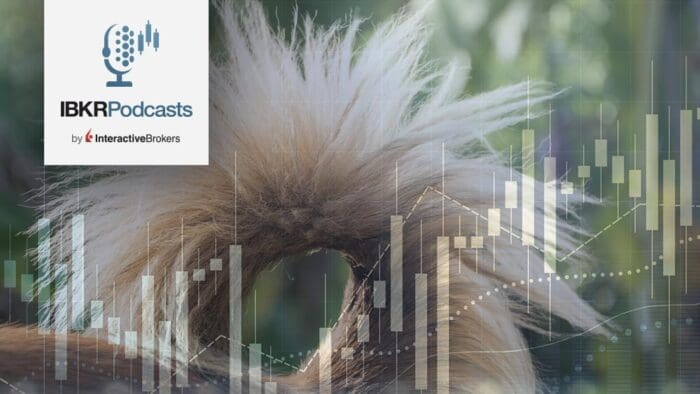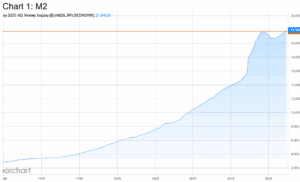Samantha LaDuc, founder of LaDuc Trading, joins Steve Sosnick, chief strategist, on a new edition of IBKR Podcasts to discuss volatility, skew, intermarket analysis and “short-termism” in equity markets.
Summary – IBKR Podcasts Ep. 47
The following is a summary of a live audio recording and may contain errors in spelling or grammar. Although IBKR has edited for clarity no material changes have been made.
Steve Sosnick
Hi everybody, this is Steve Sosnick, chief strategist at Interactive Brokers, and welcome to the latest edition of IBKR Podcasts. Today my guest is Samantha LaDuc. The first repeat guest that I’ve had – actually, well other than Thomas Peterffy, the first repeat guest that I’ve had on.
Samantha LaDuc
I’m honored
Steve Sosnick
Thank you. Samantha runs LaDuc Trading. She and I have conversed a lot about the markets, and I hope all of you enjoy the latest conversation that she and I will have now. Samantha, I’m going to throw it open to you. Just give me your basic your basic take on markets as we stand here around the beginning of the 4th – let me rephrase that — as we get to the middle of the fourth quarter.
Samantha LaDuc
Alright, yeah, well we just passed a month for the record books, right? The best October for the Dow Jones since what, 1896? And from the October 13th lows we rallied 12% in 12 days before kind of easing into this end of month. Why? Because we have FOMC obviously, tomorrow. I know this is taped a little bit early, but we have a whole bunch of market moving news coming up. Not just the Fed and the ECB on Thursday, and Nonfarm Payrolls on Friday, and next week midterm elections, and then CPI on the 10th. Lots and lots of drama into that. We’ve had a front running kind of rally based on the perception of a Fed pause or pivot. I think at the very best, in a nutshell, we might get a step down [in rate hikes], which I think will be reversed later, but that’s not a pivot, it’s not a pause. For the most part we definitely had a very strong move off that October 13th low that was triggered by short covering and then the infamous the Bank of Japan intervention with ¥5 to ¥6 trillion to support the markets on Friday morning the 21st of October which really caused CTAs to buy to cover. And a lot of FOMO. So, there was basically a crash up and scurrying for upside calls. And that is basically also for the record books. We basically have this right tail move in the option market or the market structure with folks that were terrified of missing the pivot rally.
So, we had a massive upside versus downside pivot on not just the 13th but also the 21st, when literally the day before I had given clients — and also on Twitter — a warning, literally, “brace for impact if Powell won’t defend here,”. It was literally my warning on Thursday and then it just so happened the next morning we had a massive Bank of Japan yen intervention, and then we also had the Treasury Secretary Yellen floating this theme of Treasury buybacks that put a stay of execution in the bond market which had been crashing solidly. So, we’ve had this… I would call it a stay of execution, not a pardon. In the bonds, let’s say stabilization.
And with that we had a pullback in the dollar-yen and that helped to create some softness in yields and softness in the dollar and that just spurred this risk-on rally. We had quite a two-week return that is now starting to… let’s just say digest… and a worry that perhaps the Fed is not going to pause as they have been pricing in the past few weeks and won’t pivot either because inflation is very sticky. Everywhere from wage demand growth, right straight through to PCE, and ISM, and prices paid, and on and on. There is still, I think, way too much “hopium” on this Fed pivot. And I think you kind of agree on that point.
Steve Sosnick
Well, I’m going to throw a phrase out at you that I don’t know if I’ve used on you before: “pause is the new pivot.” Do you feel that that might be the case? I think right now people are looking so hard for anything that might come from the Fed in terms of rhetoric. When the RBA, the Reserve Bank of Australia didn’t raise rates as much as they were expected to a couple meetings ago and then Bank of Canada didn’t, I asked people, “had you ever even heard of the RBA before you used that as your bullish motivator?”
The other one I’m going to throw at you is that I’ve used as well is: “FOMO is a terrible motivator.” You brought up FOMO as well, and I’d like your opinion as to whether FOMO is fear or greed? Or is it some sort of weird mix of both?
Samantha LaDuc
It’s lack of perspective on positioning that is longer term. It is short-termism. You have this massive options market now that is the flea on the tail of the dog that’s actually moving the underlying. The options market has basically this regime shift, of day traders, whether they be retail or institutional. You know 48% of options traded are weeklies, right? They’re now 0-1 days till expiry. I call it destination till empty, which is basically what’s driving the quants and the CTA’s to be mathematically and mechanically buying and selling. It’s taking all the fun out of it. Basically, as long as you can follow the quants and the CTA’s, macro still matters. I think the market’s big picture is all about a higher rate regime and yield curve inversion, recession risk, economic growth, slowdown and peak valuation for earnings
Steve Sosnick
OK.
Samantha LaDuc
Earnings are also slowing down moving forward, but right now there’s just so much market structure that’s driven by the optionality of these CTA’s and quants. And it absolutely is in coordination with, as you just said, RBA, Bank of Canada underwhelming with a 50-basis point hike instead of 75. With ECB, we’re going to stop the tightening QT. Then you have the Fed and Treasury floating that article, not once, not twice, but three times over the weekend. So, on Monday we had no choice but to rally and move higher and then more Bank of Japan easing. I mean their last easing. In fact, the stimulus that they pulled was 10 times that of the intervention that they had just put in the prior week to backstop their bond market on the 21st. It’s pure and simple as far as manipulation.
But it is absolutely tradeable, so we have to now try and guess what happens for this Fed meeting and we’ve had this Fed whisper. “Pivot the pivot and then pivot again and pivot again” in regard to what the Fed is really trying to telegraph and have the market interpret. So, there’s a lot of this, let’s just say “fear of missing the rally” on a pause that could bring us higher, and I can see that reason technically. We could see that obviously in the technicals, but it’s not in the macro. It’s not in the fundamentals. It’s most certainly not in my intermarket, which is my mainstay of interpretation of what’s happening in the market.
Steve Sosnick
Well, that was really where I was going to try to go anyway. You’re very good at the intermarket analysis, and let’s tie it into sort of the day trading that you mentioned.
Samantha LaDuc
That’s my script.
Steve Sosnick
Do you find that the intermarket analysis gives you better signals for counter-trend trading? For you know since the trends can last as little as an hour and a half. At this point, if everybody is trading shorter options, how do you use that? Do you fade moves or do you jump on them, or some of each?
Samantha LaDuc
I always move back in time first and foremost, meaning I look at the trend because I want to swim with the current, not against it, and I think that’s much more powerful. And then, by the way, that’s on a monthly or on a weekly basis where you have a sustainable direction. Once that starts to go into distribution, I can see it in my intermarket analysis. I call it this a “sold to you” rally. We talked about…
Steve Sosnick
[Chuckles] Yes, huh
Samantha LaDuc
… that from the very top over. Why hedge what you’re selling, right? It was a “sold to you” market. Solid distribution all the way through to the FAANG stocks, every single one. But Apple – the last general standing, yeah? We have this situation where intermarket, in my opinion, shows very clearly under the surface the distribution from a larger time frame. And I do my comparisons with the yield right across the market indices. The dollar-yen volatility, and on and on, it all says the same thing — “Bear Market rally”. [It said it] For March. Again, in June. A little one again, July 15th through August 16th, a bear market rally. And this one as well, it says bear market rally. There’s been nothing compelling in my intermarket analysis on any trend or swing time frame that says “this is safe”. It says we’re going to have a short covering rally that can turn into something powerful that will then be “short the rip.”
So, the question is, how far will this particular short covering rally move? Could it go into that 4,130 area? That’s my upside measured move target for this rotation on mechanical flows alone. Or can we just basically agree that the Fed is trapped and that no matter what they do, yields are going to pop up like a daisy and oil with it. And then all bets are off.
Steve Sosnick
Well, to me, that is the is the big crux of the question. Ultimately, I’ve been saying this for quite some time. I think the listeners are probably tired of hearing me say this, but if “don’t fight the Fed” was your mantra on the whole way up, it has to apply on the way down. And my bigger concern is we’ve barely seen QT get started. QT has been in place for maybe a month and a half. The balance sheet isn’t really typically shrinking by about $95 billion a month, although there is some natural growth to it as the economy grows. I grant that you’re not going to see it, but deflating the balloon is more fraught with risk than inflating it. The imminent risk, and we’ve seen that when Bank of England had to step in, the Bank of Japan had to step in. I think people misunderstand the “Fed Put “as being something that the Fed is going to step in if stocks decline. I’d like your opinion on this. Mine is that the “Fed Put” has nothing to do with stocks. Stocks are collateral damage. It’s to the extent that a stock market decline creates problems in the credit cycle or the credit markets or the banking system, or to the extent that a stock market decline reflects that. Sure, then the Fed comes in. But basically, the Fed’s not set up to keep equity markets propelled or propped.
Samantha LaDuc
I don’t know what their true motivation is. All I can do is track what they keep saying, which is just before we’re going over the precipice. And there are very clear indicators for me. When I warn “brace for impact if bulls don’t defend here”, by golly they show up. They show up with some teaser Wall Street Journal article or some Yellen statement about talking about Treasury buybacks, or lo and behold, there’s a massive yen intervention by the Bank of Japan. Seriously, it’s as if they want to make sure there’s a soft landing, right, and we’re still gonna go lower. We’re still making lower lows on a weekly, lower highs on a weekly, claiming we’re still bear market rallying ourselves down the mountain.
We talked about that last, I don’t know, March when we spoke. To me we danced up the mountain and now we’re dancing down. To me, I still see solid distribution. And whether it is in the intermarket, also in the macro, there’s no reason to really be sustainable at this Fed pivot mantra when we have the threat of higher oil and sticky inflation, and wage demand is not going away. And then we have this underwhelming narrative of, “who’s buying this rally anyway, stock buybacks? You know they’re pretty firm into the end of the year”. CTAs? OK, but I don’t want to say they’re real buyers there. There’s not a committed cadre of treasury buyers stepping in, right? It’s basically this soft landing approach to going lower over time, instead of over the cliff all at once.
Steve Sosnick
Well, I certainly understand the motivation for using moral suasion or however you want to put it because they don’t want… nobody wants a hard landing. I think that goes out of the question.
One thing you mentioned was the three-month cyclicality. I wrote something at the end of October, which stunned me. I thought “wait, the numbers for October seem a lot like July” and I actually ran the numbers for S&P. The monthly returns in June and July and the monthly peak to trough drawdown and high-low ranges for both for June and July were almost… June was almost identical to September, and October was almost identical to July. Granted, the Dow got so much attention because the Dow was so stunning.
Samantha LaDuc
Yes, it did.
Steve Sosnick
But I prefer to think about market cap weighted indexes rather than the Dow, which is price weighted, AKA randomly weighted. But when I looked at the S&P the returns were almost identical. How much do you look at cyclicality in your studies and your work? How much does it come into play, because I do think that both in both cases, we had events coming into the end of the quarter that were then resolved at the end of the quarter. Then things sort of eased both times as a combination of earnings over-pessimism that didn’t resolve itself in both cases. How much do you get into the cyclical aspect of it?
Samantha LaDuc
I wish that was a strength honestly. The fact is, I don’t. I find that fascinating. I didn’t know that, and it doesn’t seem so random. What I am watching is in regard to a kind of regular rotation in skew being extremely depressed and then it pops up, right? Outliers revert or VIX has fallen into its 200-day, and that’s a good place that it seems to kind of keep gyrating toward and then it pops up.
There are natural kinds of occurrences within the volatility structure that I’m watching that are very cyclical, but right now the most gripping cyclical feature of this market is seasonality, right? And folks are very excited about the so-called “Santa rally”, this end of year run. And then they’re going to somehow time this with precision to get out before a massive fall in 2023. That always cracks me up. Like really. This is going to be tested with midterm elections. Will we have some changes that will impact this cyclical nature of our year-end run? Sometimes we have definitely had such an outsized run like the 13-year NASDAQ outperformance. And that was my big call at the beginning of the year, that we were going to reverse that NASDAQ would underperform. I guess that’s the big picture. But I don’t study everything on a cyclical nature.
Steve Sosnick
Oh, no one can, no one can.
Samantha LaDuc
It has to be an outlier for me. Outliers are interesting, but extreme outliers revert with velocity and it’s those reversions that I’m very excited about trading.
Steve Sosnick
One thing I will say there’s plenty to be excited about. One thing that I will point out here is the last midterm election was 2018. That was also the last time the Fed was raising rates while QT was in effect at the same time. I think people were sort of hoping for that end of the year bounce. And that was that was one of the worst year-ends we’ve had in a long time. It ended only when the Fed came out at the December meeting and said “we are done”. Now the Fed can’t really do that now quite to the same extent because they didn’t have to worry about inflation so much…
Samantha LaDuc
100% yeah.
Steve Sosnick
So, this is the idea. Weird story here, but for my masters thesis, I studied it what was called Decision Sciences at the time, along with Finance. It’s now called Behavioral Economics. One of the things I did was work with a professor who was doing stuff about seat belt usage and why don’t people wear seatbelts? It was when seat belt laws were new and somewhat controversial. One of the things that you would get a lot of times was, “if I’m wearing a seat belt, I can’t get out of the car at the last minute or be thrown from danger”, which assuredly from the research was the surest way to meet a gruesome end, rather than being encased in several thousand pounds of steel with safety features. And that always sticks with me, the idea that I can time this at the last possible second, jump out of the way.
Samanth LaDuc
OK.
Steve Sosnick
It’s fallacious if you’re in an automobile. And I think it’s just as just as much of a fallacy if you’re in if you’re in the markets.
Samantha LaDuc
It is really, really interesting that you say this because we talked about this also back in March with that rally that we both believed was a bear market rally, and that was that I’m really good at timing tops because I can see distribution, right? Big picture trends swing, day timeframe but event but the bottoms are events. When you talk about the two. I remember [October 2018] very specifically. On October 3rd, the 10-year was 3.2% and I warned, “this is going to cause emerging market panic.” I remember that. We pulled back 20% into the [December 23rd, 2018] Christmas Eve massacre, as it was called, right after we had a 20% pullback and Manchin called the banks. And then the FOMC. I mean the next meeting in the rest is history. Yeah, that was an event that saved the markets. Bank of Japan, even on Friday, the 21st [of October 2022] saved the markets along with Yellen’s talking about talking about Treasury buybacks.
Steve Sosnick
I’m just going to interject Bank of England on September 28th or whatever it was. So yes.
Samantha LaDuc
Yep, exactly and the intervention now is becoming expected. But it’s also because it’s diminishing returns. They’re not able to really give anything more than these short duration trades, be it retail or institutional. You know, cover and then the CTA’s buy to cover and the whole thing then tops out. And it’s short the rip again, so it’s extremely tradable. But it also makes it more fragile, right? When we have these once in a lifetime intraday spikes. In SPX, we had one that was, I don’t know, 5% back on the 13th. We were negative 1,900 ticks and then we turned around to positive 1,900 ticks in a New York minute. This is not stability. So yes, I think that this is the danger, when I start to see the the ground give sway. That’s when I warn clients, “hey brace for impact if bulls don’t defend here. This is a really good place to have some crash protection.”
In the same way we’ve got this meeting tomorrow, and we have a technical bounce underway that could absolutely bring us higher, like I said, to 4130, but the reality of the fact is that we also have no one really properly hedged. They’ve been doing this systematic mechanical buying and the rub is if yields do start to take off then we’re absolutely going to be in a situation where the extremes, given that everyone rushed to buy the upside skew, are so depressed. VIX is also very, very low, relatively speaking to the recent cycle, then the downside tail has been forgotten, and that can actually present a good value right for buying protection into this event. That’s where I really see where inflation is not going away. Still all eyes on the Fed. Nothing really changed as it relates to the macro, the fundamental or my intermarket. Interestingly enough, all we’ve had is some short-term short covering of size that basically stresses bears out who are “HODL’ing” puts and traps bulls who are chasing because of FOMO, which is a disease, I agree.
Steve Sosnick
Well, one of the things it’s interesting that to me is one of the tells you mentioned: VIX. We’re going to end with VIX ’cause I want you know I want to keep this like 20-ish minutes, and you and I’ve talked for 20 minutes and haven’t even come up for air because it’s been such a good conversation. So, I hope the listeners like it. They’ll also find out if we’re smart or stupid about the Fed, because this will probably air after the Fed meeting.
One of the one of the tells in October was that VIX was not moving inversely with S&P. That to me was the tell that it was FOMO driven. That people were coming for calls and ’cause these rallies were so violent on the upside. But as we’re taping this, we’ve sort of reverted back to normal. The market and VIX has come off. It’s got a 25 handle as we’re taping this. What’s your opinion? My feeling is that VIX needs to be no less than the high 20s on a sustainable basis with the volatility that has been persisting and with the Fed continuing to be a headwind.
Let’s wrap up with your take. Take VIX into the end of the year. You mentioned that you think it’s a little low right now. Where do you think it goes? And I’m not asking you if it’s going to be 28.02 on December 31st.
Samantha LaDuc
No, no. I actually have very specific levels of VIX
Steve Sosnick
[laughs] OK.
Samantha LaDuc
I love 25.10 as a as a place of support and bounce. I love 31 [as a high end]. It typically it gets up to that 31 and then snakes around it and comes back below. Below is obviously market bullish; above is not. And once it does get not just get back above 31 but above 34-35, then I see a very large volatility move.
In the meantime, an FOMC meeting like this is volatility suppression at its finest, and it does this repeatedly. We basically have this situation where every rally has been sold as soon as Powell gets to the podium. Jackson Hole tough talk. We definitely have had multiple equity rallies on the back of this perceived easing. And then Powell comes up and says not so fast, right? So, it’s really a situation where I think we’re going to. Those are my levels, literally 25-31, and then anything above 34 1/2 is kind of like get under the desk.
But the point is it, for me it means there’s going to be a continuation of this Fed hiking regime for longer. So maybe the pace slows. That’s not a pivot, right? It might be a step down, but the problem doesn’t go away. And if they step down too much, the market will let them know, especially in the form of oil. I think right now Apple is very much a tell for the generals. Volatility stays suppressed. I’m not so concerned about that. Definitely FX currencies are a major warning, especially the dollar-yen and I think oil right now has been subdued, but it will be your release valve with the dollar on any Fed, pause, pivot, pandering there is. I think the market will absolutely be reminded.
Steve Sosnick
Well, I was gonna ask you to wrap it up, but I think we just did so I think.
Samantha LaDuc
You didn’t ask about midterm elections, ’cause I have no idea, no opinion. I think that’s definitely a wild card for sure.
Steve Sosnick
I’m staying away partly because this might not air until after the midterm elections, and partly because nobody knows what’s going on with those. I think you put everything in such a neat bow. I think we’re going to wrap it up here.
Samantha LaDuc
Well, thank you so much.
Steve Sosnick
Thank you to my guest Samantha LaDuc of LaDuc Trading. I’m Steve Sosnick at Interactive Brokers. You’ve been listening to IBKR Podcasts. You can find IBKR podcasts on the Internet or on your favorite podcast provider. I assume you already listening, actually. I write daily at tradersinsight.news. Samantha is a must follow on Twitter. She and I go back and forth on Twitter sometimes, but I think that’s a healthy dialogue. And we’re going to wrap it up here. Thank you so much for joining us, Samantha. Thank you so much for listening everybody and we’ll talk to you again soon. Take care.
Disclosure: Interactive Brokers
The analysis in this material is provided for information only and is not and should not be construed as an offer to sell or the solicitation of an offer to buy any security. To the extent that this material discusses general market activity, industry or sector trends or other broad-based economic or political conditions, it should not be construed as research or investment advice. To the extent that it includes references to specific securities, commodities, currencies, or other instruments, those references do not constitute a recommendation by IBKR to buy, sell or hold such investments. This material does not and is not intended to take into account the particular financial conditions, investment objectives or requirements of individual customers. Before acting on this material, you should consider whether it is suitable for your particular circumstances and, as necessary, seek professional advice.
The views and opinions expressed herein are those of the author and do not necessarily reflect the views of Interactive Brokers, its affiliates, or its employees.
Disclosure: Forex
There is a substantial risk of loss in foreign exchange trading. The settlement date of foreign exchange trades can vary due to time zone differences and bank holidays. When trading across foreign exchange markets, this may necessitate borrowing funds to settle foreign exchange trades. The interest rate on borrowed funds must be considered when computing the cost of trades across multiple markets.
Disclosure: Options Trading
Options involve risk and are not suitable for all investors. For information on the uses and risks of options, you can obtain a copy of the Options Clearing Corporation risk disclosure document titled Characteristics and Risks of Standardized Options by going to the following link ibkr.com/occ. Multiple leg strategies, including spreads, will incur multiple transaction costs.
Disclosure: Futures Trading
Futures are not suitable for all investors. The amount you may lose may be greater than your initial investment. Before trading futures, please read the CFTC Risk Disclosure. A copy and additional information are available at ibkr.com.




















Join The Conversation
For specific platform feedback and suggestions, please submit it directly to our team using these instructions.
If you have an account-specific question or concern, please reach out to Client Services.
We encourage you to look through our FAQs before posting. Your question may already be covered!